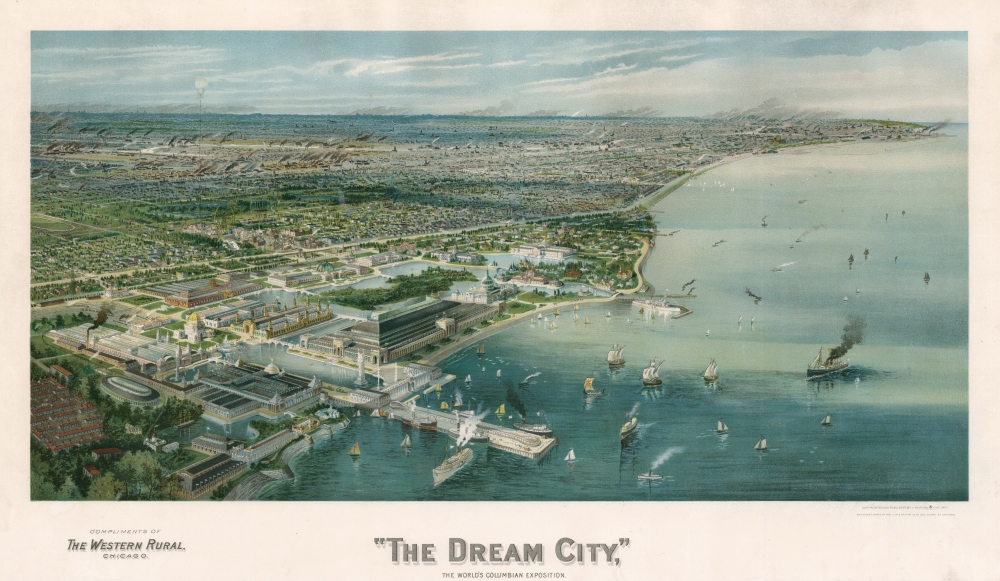This item has been sold, but you can get on the Waitlist to be notified if another example becomes available, or purchase a digital scan.
1893 American Fine Art Co. View of the 1893 Columbian Exhibition, Chicago
DreamCity-americanfineart-1893$1,450.00

Title
'The Dream City,' The World’s Columbian Exhibition.
1893 (undated) 13 x 22 in (33.02 x 55.88 cm)
1893 (undated) 13 x 22 in (33.02 x 55.88 cm)
Description
This is a beautiful and scarce chromolithograph bird’s-eye view of Chicago, Illinois, published as a promotion and souvenir for the World’s Columbian Exposition of 1893. It depicts Chicago's shore of Lake Michigan, foregrounding the buildings of the Columbian Exposition. The city sprawls in the background, with smoke pouring from dozens of chimneys: in the 19th century, a sign of progress and prosperity. The lake is filled with sailboats and steamships, some picking up and discharging passengers at the Exhibition's pier.
The White City
The view is a celebration of the architectural designs of architect Daniel Burnham. His neoclassical structures, with their white faux-stone facades, were known as the White City for their color, and also called the 'Dream City,' to reflect on the utopian optimism it was meant to evoke. A first-hand account of the opening day captures the exhibition's spirit:With what joyous hearts and eager eyes, we first stepped through the turnstile at the 60th street entrance to the great Columbian Exposition of '93. For three years we had talked of it, dreamed of it, read about it, and now at least it was a thing accomplished and we had entered the charmed precincts.... Words fail! The magic splendor of that sight can never be excelled on earth. The Snowy palaces, the golden domes, the airy flying figures that crowned them, the fluttering flags and slow waving banners, the columned arches, and deep-vaulted porticoes; the green velvet of the turf; the flashing blue of the water; the floating grace of the figures of the McMonnies’ [sic] fountain; the solemn majesty of the statue of the Republic; and beyond all, the divine beauty of the peristyle with its myriad columns outlined against the cloudy blue of the lake; the springing grace of the quadriga painted on the vanishing purple of the spring sky. What pen can tell its beauty! What tongue can breathe the nameless spell, the wordless charm, the hold peace and quiet of that scene! Will the new Jerusalem be fairer? Will the courts of heaven give a sweeter calm, a deeper rest? 'I know not, Oh I know now what joys await us there,' but surely earth, can give us no more. We were not the only ones who felt those charms. Every one about us moved softly and spoke gently. No one seemed hurried or impatient, all were under a spell, a spell that held us from the opening of the fair until its close. How long we stood and gazed we do not know. Halcyon Days in the Dream City 1894 by Mrs. D. C. Taylor
The Battleship That Never Sailed
Near the center of the view, at one of the northern piers of the fair, is a warship. The United States Navy intended, among the wonders displayed at the Exposition, to showcase its steel-hulled, electric-lit battleships. This posed two problems: First, treaties with Canada forbade warships of either nation to operate on the Great Lakes. Second - before the 1900 opening of the Sanitary and Ship Canal - the draft of a steel-hulled warship would be unable to enter or leave the lake. The solution - itself, arguably a quintessentially American scheme - was to fabricate a full-scale ersatz battleship - dubbed the Illinois - to show off the Navy’s new technologies. This 'ship' was designed by architect Frank W. Grogan, and built of pilings and timbers from the lake floor on up: above the waterline it sported brick sides plastered with cement to simulate the steel hull of the Indiana-class battleships she was meant to represent. Actual coal - fired generators powered the Illinois' electrically-driven turrets, her interior lighting, and her powerful searchlights. She had a skeleton Navy crew made up of officers and sailors.Chromolithography
Chromolithography is a color lithographic technique developed in the mid-19th century. The process involved using multiple lithographic stones, one for each color, to yield a rich composite effect. Oftentimes, the process would start with a black basecoat upon which subsequent colors were layered. Some chromolithographs used 30 or more separate lithographic stones to achieve the desired effect. Chromolithograph color could also be effectively blended for even more dramatic results. The process became extremely popular in the late 19th and early 20th centuries, when it emerged as the dominate method of color printing. The vivid color chromolithography produced made it exceptionally effective for advertising and propaganda imagery.Publication History and Census
While we are aware of a handful of examples that have appeared on the market in the past ten years, it is nevertheless scarce. We see only one example in OCLC, cataloged at the Yale University Library.Cartographer
American Fine Art Co. (fl. 1890s) were a Milwaukee - based commercial lithographic press whose output spanned from advertisements of patent cures to beautiful panoramic city views. They commissioned work from a wide variety of artists, seldom crediting any of them on their printed output (to the confusion of the modern collector and dealer.) More by this mapmaker...
Condition
Very good. Superb chromolithograph with some areas of refreshing. One virtually invisible surface mend.
References
OCLC 71008579.

